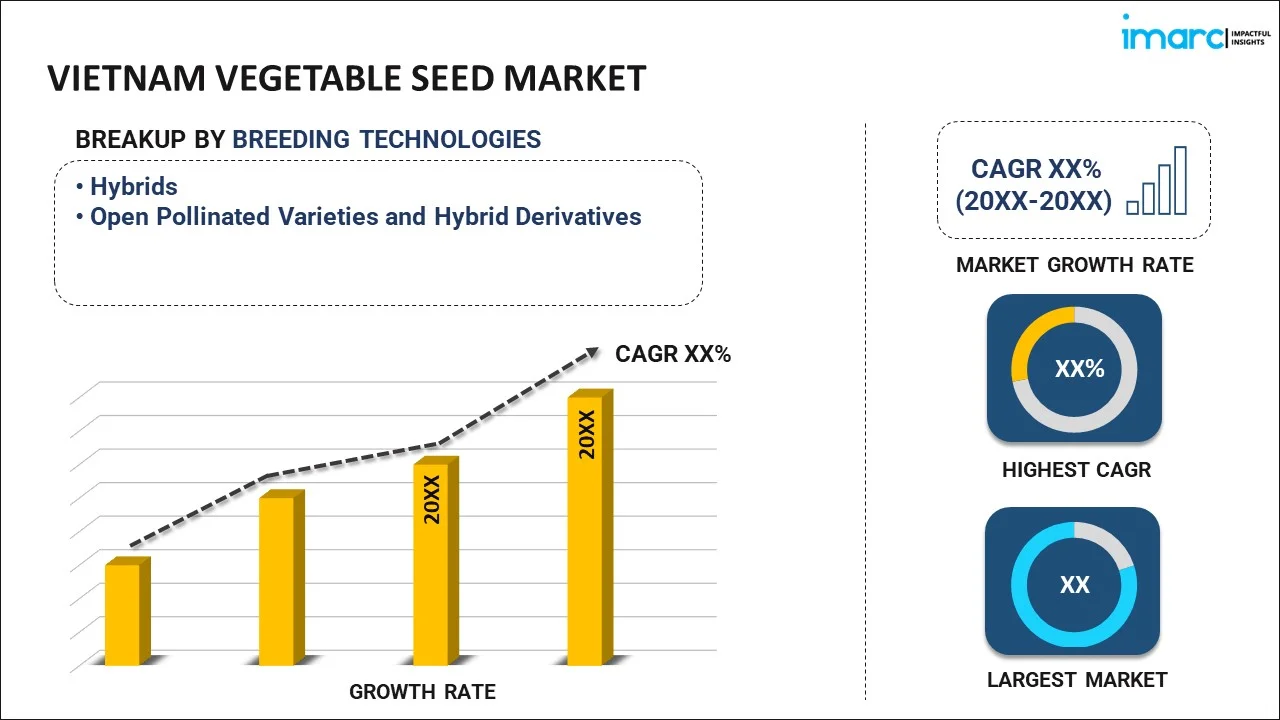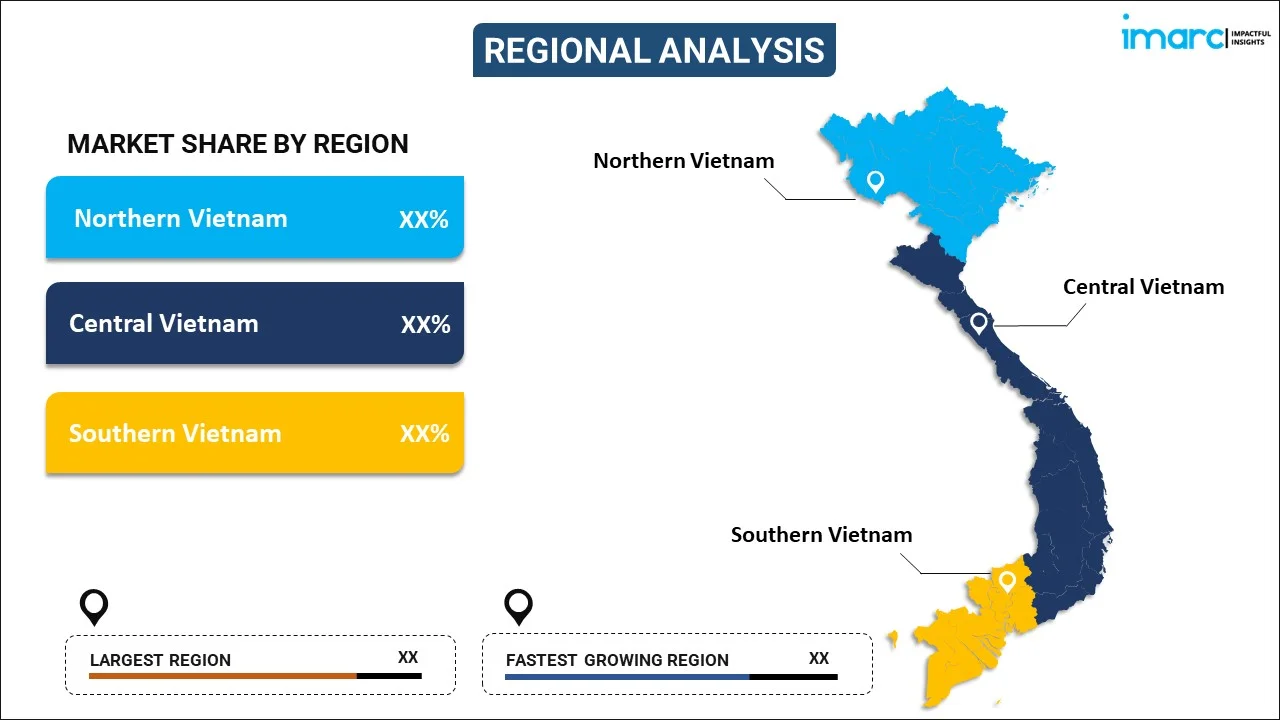
Vietnam Vegetable Seed Market Report by Breeding Technology (Hybrids, Open Pollinated Varieties and Hybrid Derivatives), Cultivation Mechanism (Open Field, Protected Cultivation), Crop Family (Brassicas, Cucurbits, Roots and Bulbs, Solanaceae, Unclassified Vegetables), and Region 2024-2032
Market Overview:
Vietnam vegetable seed market is projected to exhibit a growth rate (CAGR) of 4.23% during 2024-2032. The rising demand for vegetables and seeds for home gardening, increasing demand for new seed varieties, favorable government agricultural initiatives, and shifting preference toward diverse and exotic vegetables represent some of the key factors driving the market.
|
Report Attribute
|
Key Statistics
|
|---|---|
|
Base Year
|
2023 |
|
Forecast Years
|
2024-2032 |
|
Historical Years
|
2018-2023
|
| Market Growth Rate (2024-2032) | 4.23% |
Vegetable seeds are the fundamental units of plant reproduction that give rise to various edible plants, including vegetables, herbs, and legumes. They are specifically cultivated for their capacity to produce plants that yield edible and nutritious parts, such as leaves, roots, stems, flowers, and fruits, which are commonly consumed as a primary source of nutrients in human diets. They are available in diverse shapes, sizes, colors, and textures, reflecting the wide variety of vegetables they can produce. Each seed contains genetic information that determines the characteristics of the resulting plant, including its flavor, size, color, disease resistance, and growth habits. The cultivation of vegetable seeds is a critical component of agriculture, as it provides the foundation for sustainable food production. Farmers and gardeners carefully select and plant these seeds in suitable soil and environmental conditions, nurturing them through various stages of growth until they mature into harvestable crops. These seeds also play a crucial role in the world's food security, as they enable the production of a wide range of nutritious and culturally important vegetables that contribute to global diets. At present, vegetable seed finds extensive applications for maintaining biodiversity and preserving heirloom varieties of vegetables across Vietnam, ensuring a rich tapestry of flavors and nutritional options for future generations.
Vietnam Vegetable Seed Market Trends:
The Vietnam vegetable seed market is experiencing significant growth driven by the growing need for high-quality vegetable seeds due to the increasing awareness of the importance of a balanced diet and the rising demand for fresh, locally sourced vegetables. Moreover, the expanding middle-class population and inflating disposable incomes have fueled greater consumption of vegetables, thereby augmenting the demand for improved seed varieties. Apart from this, the rising prevalence of climate change and the escalating need for more resilient crops that prompt farmers to seek out advanced seed technologies is another major growth-inducing factor. Additionally, several favorable government initiatives to promote modern farming practices and improve agricultural productivity have accelerated the adoption of quality vegetable seeds. Besides this, rising investments in seed research and development (R&D) to meet international quality standards owing to the increasing export potential of Vietnamese vegetables has catalyzed market growth. Along with this, the heightening weather uncertainties that necessitate the development of seeds that can adapt to changing environmental conditions is another major growth-inducing factor. Furthermore, the rising demand for new seed varieties due to the evolving dietary habits and a preference for diverse and exotic vegetables is contributing to market growth.
Vietnam Vegetable Seed Market Segmentation:
IMARC Group provides an analysis of the key trends in each segment of the market, along with forecasts at the country level for 2024-2032. Our report has categorized the market based on breeding technology, cultivation mechanism, and crop family.
Breeding Technology Insights:

- Hybrids
- Open Pollinated Varieties and Hybrid Derivatives
The report has provided a detailed breakup and analysis of the market based on the breeding technology. This includes hybrids and open pollinated varieties and hybrid derivatives.
Cultivation Mechanism Insights:
- Open Field
- Protected Cultivation
A detailed breakup and analysis of the market based on the cultivation mechanism have also been provided in the report. This includes open field and protected cultivation.
Crop Family Insights:
- Brassicas
- Cabbage
- Carrot
- Cauliflower and Broccoli
- Others
- Cucurbits
- Cucumber and Gherkin
- Pumpkin and Squash
- Others
- Roots and Bulbs
- Garlic
- Onion
- Potato
- Others
- Solanaceae
- Chilli
- Eggplant
- Tomato
- Others
- Unclassified Vegetables
- Asparagus
- Spinach
- Others
The report has provided a detailed breakup and analysis of the market based on the crop family. This includes brassicas (cabbage, carrot, cauliflower and broccoli, and others), cucurbits (cucumber and gherkin, pumpkin and squash, and others), roots and bulbs (garlic, onion, potato, and others), solanaceae (chilli, eggplant, tomato, and others), and unclassified vegetables (asparagus, spinach, and others).
Regional Insights:

- Northern Vietnam
- Central Vietnam
- Southern Vietnam
The report has also provided a comprehensive analysis of all the major regional markets, which include Northern Vietnam, Central Vietnam, and Southern Vietnam.
Competitive Landscape:
The market research report has also provided a comprehensive analysis of the competitive landscape in the market. Competitive analysis such as market structure, key player positioning, top winning strategies, competitive dashboard, and company evaluation quadrant has been covered in the report. Also, detailed profiles of all major companies have been provided.
Vietnam Vegetable Seed Market Report Coverage:
| Report Features | Details |
|---|---|
| Base Year of the Analysis | 2023 |
| Historical Period | 2018-2023 |
| Forecast Period | 2024-2032 |
| Units | US$ Million |
| Scope of the Report | Exploration of Historical Trends and Market Outlook, Industry Catalysts and Challenges, Segment-Wise Historical and Future Market Assessment:
|
| Breeding Technologies Covered | Hybrids, Open Pollinated Varieties and Hybrid Derivatives |
| Cultivation Mechanisms Covered | Open Field, Protected Cultivation |
| Crop Families Covered |
|
| Regions Covered | Northern Vietnam, Central Vietnam, Southern Vietnam |
| Customization Scope | 10% Free Customization |
| Report Price and Purchase Option | Single User License: US$ 3699 Five User License: US$ 4699 Corporate License: US$ 5699 |
| Post-Sale Analyst Support | 10-12 Weeks |
| Delivery Format | PDF and Excel through Email (We can also provide the editable version of the report in PPT/Word format on special request) |
Key Questions Answered in This Report:
- How has the Vietnam vegetable seed market performed so far and how will it perform in the coming years?
- What has been the impact of COVID-19 on the Vietnam vegetable seed market?
- What is the breakup of the Vietnam vegetable seed market on the basis of breeding technology?
- What is the breakup of the Vietnam vegetable seed market on the basis of cultivation mechanism?
- What is the breakup of the Vietnam vegetable seed market on the basis of crop family?
- What are the various stages in the value chain of the Vietnam vegetable seed market?
- What are the key driving factors and challenges in the Vietnam vegetable seed?
- What is the structure of the Vietnam vegetable seed market and who are the key players?
- What is the degree of competition in the Vietnam vegetable seed market?
Key Benefits for Stakeholders:
- IMARC’s industry report offers a comprehensive quantitative analysis of various market segments, historical and current market trends, market forecasts, and dynamics of the Vietnam vegetable seed market from 2018-2032.
- The research report provides the latest information on the market drivers, challenges, and opportunities in the Vietnam vegetable seed market.
- Porter's five forces analysis assist stakeholders in assessing the impact of new entrants, competitive rivalry, supplier power, buyer power, and the threat of substitution. It helps stakeholders to analyze the level of competition within the Vietnam vegetable seed industry and its attractiveness.
- Competitive landscape allows stakeholders to understand their competitive environment and provides an insight into the current positions of key players in the market.
Need more help?
- Speak to our experienced analysts for insights on the current market scenarios.
- Include additional segments and countries to customize the report as per your requirement.
- Gain an unparalleled competitive advantage in your domain by understanding how to utilize the report and positively impacting your operations and revenue.
- For further assistance, please connect with our analysts.
 Inquire Before Buying
Inquire Before Buying
 Speak to an Analyst
Speak to an Analyst
 Request Brochure
Request Brochure
 Request Customization
Request Customization




.webp)




.webp)












